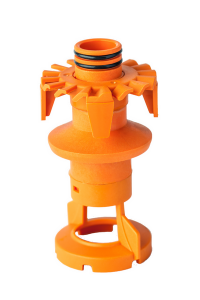How Does a Water Separator Work?
Understanding the purpose and components of a water separator in a compressed air system.
Posted on March 14th, 2023
Compressed air filters are designed to efficiently remove oil and water aerosols from an air stream while, regenerative dryers are designed to remove water vapor only. However, both filters and dryers struggle with high levels of liquid water. When liquid water accumulates in a compressed air system, it can cause several issues. That is why including a water separator is important. It removes the accumulated, bulk water within a system to avoid corrosion of pipework and equipment and avoid damaging delicate instruments. But how does this water enter the compressed air system in the first place?
How Moisture Enters a Compressed Air System
Compressed air typically contains moisture in three different forms: vapor (invisible moisture), aerosols (visible, cloud/fog), and liquid. Vapor is the only form that is present in the air as it is originally drawn into the compressor. The other two forms are produced throughout the compression process.
Air is compressible but moisture is not. As the air is compressed, it’s volume decreases, while the water volume remains the same. This results in a steady increase in the air’s humidity level. As air is compressed, it becomes very hot (194°F, 90°C) and its moisture vapor holding capacity increases greatly. The airs capacity to hold moisture vapor varies by temperature but as a general rule of thumb, for every 20°F (11°C) increase in temperature, a given volume of air can hold twice as much water vapor.
Unfortunately, the newly compressed air is too hot to be used and therefore must be cooled. As the temperature of the air drops to a usable temperature, condensation starts to occur. The condensation converts water vapor into aerosols and liquid water. Additional cooling can also occur as the air sits in a receiver or passes through downstream pipe work.
The Spinner in a Centrifugal Water Separator
Centrifugal water separators work by taking the compressed air as it enters the housing and forcing it into a circular vortex (also known as a spinning action) around the inside of the housing. This centrifugal action forces the water against the inner walls of the separator where it works its way to the bottom of the housing to be drained as needed. The air, free of its liquid water, exits the housing by traveling up the center of the spinner and out the outlet.

Centrifugal water separators require the centrifugal force to “spin out the water.” When the airflow is low there is less force to work with. Meaning, that water separators typically work better when the airflow is high.
As the speed of the air moving through the housing increases, the flow patterns change. The air may move smoothly at one flow rate and then become turbulent at another. This turbulence, often referred to as “noise,” leads to the lows of an efficiency curve. The desired spinning action is disrupted and the efficiency drops. As the speed of the air increases further, the noise lessens, and the spinning action is restored.
The Most Efficient Water Separators
Throughout the years’ Walker Filtration has developed water separators that are efficient even at low velocities. The unique spinner design reduces turbulence, allowing for an uninterrupted spin and higher liquid removal. The more liquid removal, the more energy efficient the system is and the less corrosion that could occur, which saves our customers money.
To learn more about the Walker Filtration water separators, please download our datasheet here or contact our sales team.